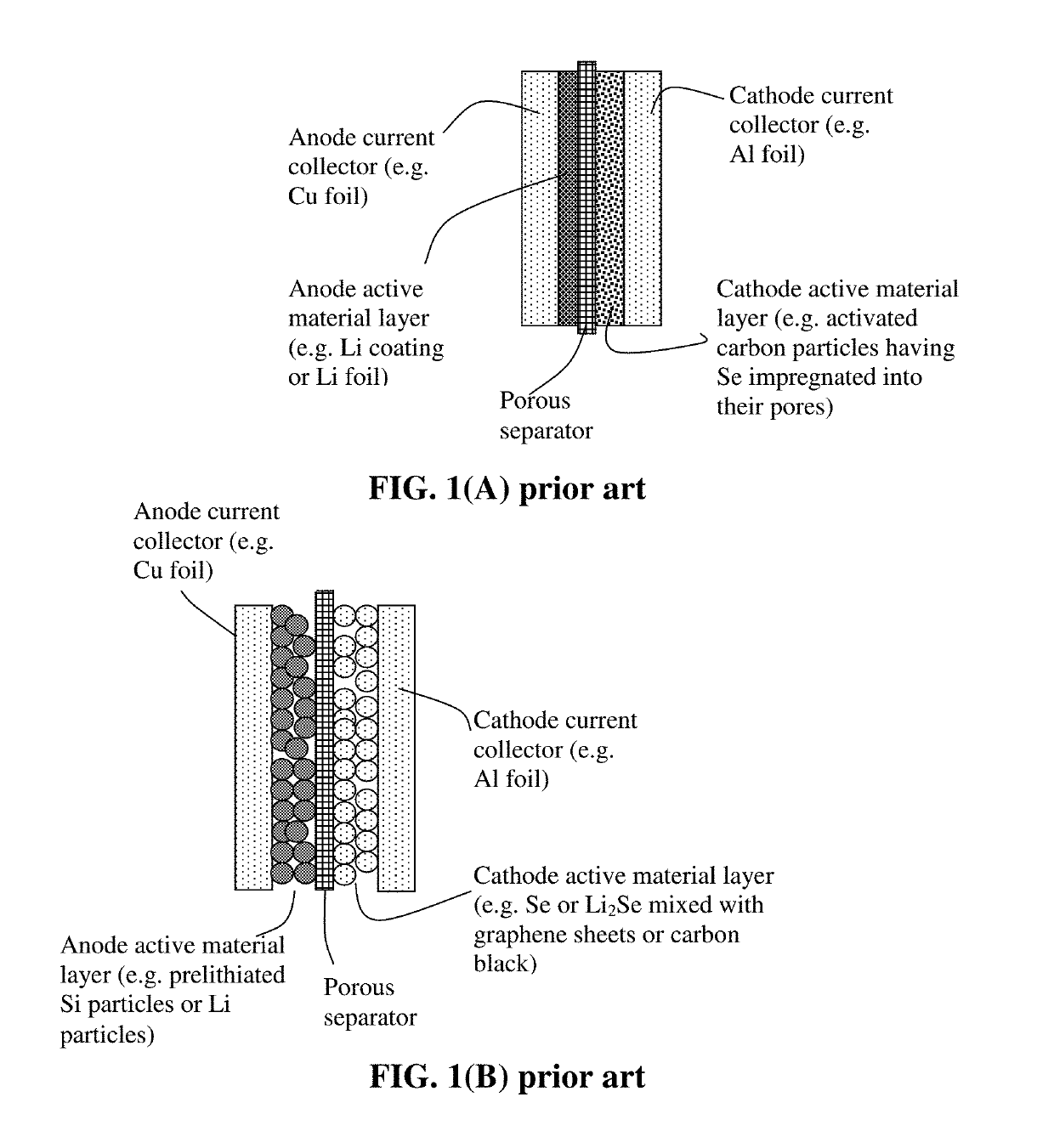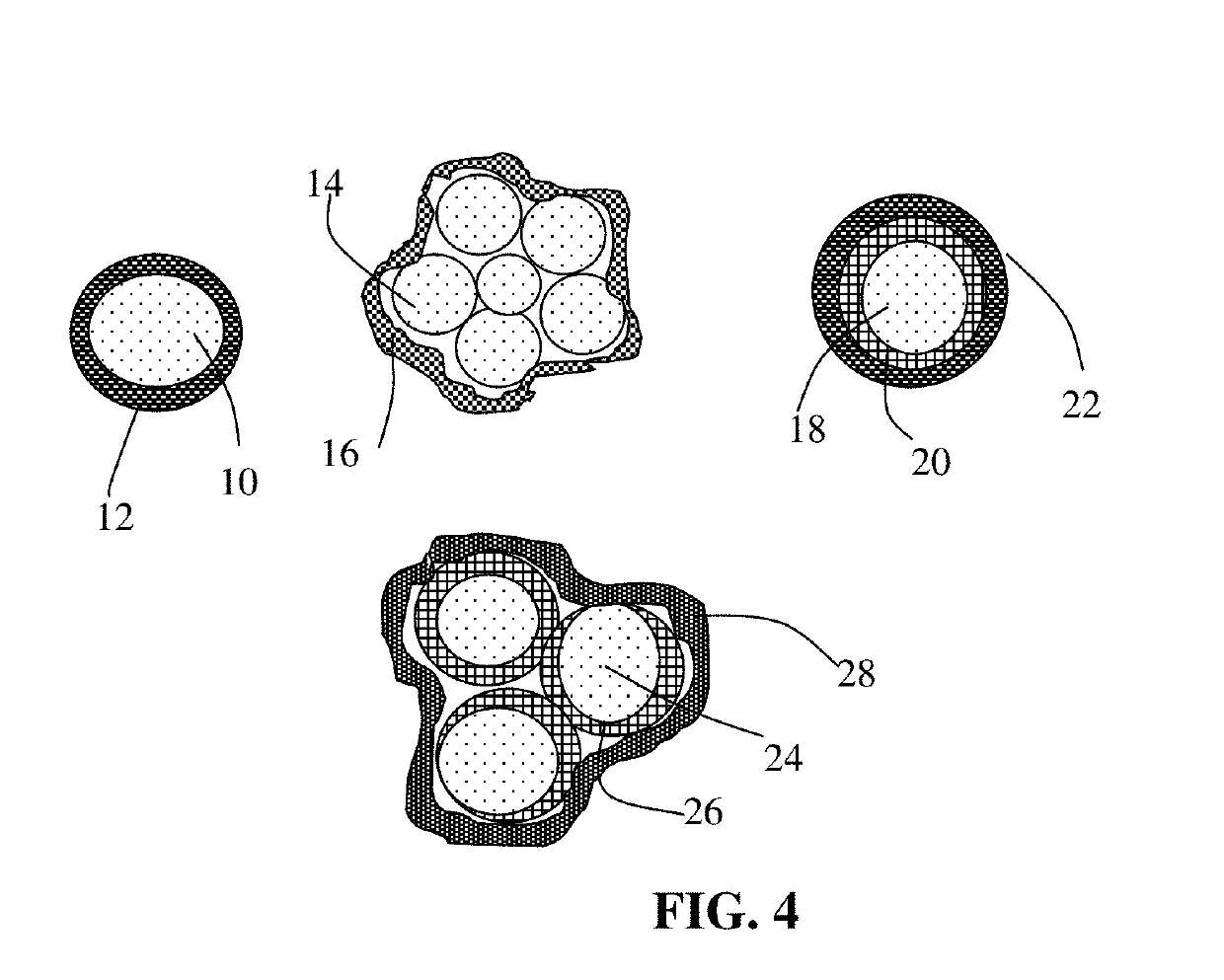Alkali metal-selenium secondary battery containing a cathode of protected selenium
- Summary
- Abstract
- Description
- Claims
- Application Information
AI Technical Summary
Benefits of technology
Problems solved by technology
Method used
Image
Examples
example 3
on of Selenium Nanowires
[0166]Selenium nanowires were synthesized from SeO2. In a typical reaction process, SeO2 (0.25 g) and β-cyclodextrin (0.25 g) were added into a glass beaker containing 50 mL distilled water. The mixture was stirred for about 10 min to give a clear solution, which was promptly poured into another glass beaker containing ascorbic acid solution (50 mL, 0.028 M) under continuous stirring. After reacting for 4 h, the product was collected by centrifugation and washed with deionized water and absolute ethanol several times. Then it was re-dispersed in ethanol and allowed to age for 2 h without stirring. Subsequently, the products were dried in a vacuum at 60° C. for 5 h to recover Se nanowires.
Example 4: Hydrothermal Synthesis of Se Nanowires from (NH4)2S2O3 and Na2SeO3
[0167]A low-temperature hydrothermal synthesis route was conducted for direct production of crystalline trigonal selenium nanowires, using (NH4)2S2O3 and Na2SeO3 as the starting materials in the pre...
example 5
on of Se Nanoplatelets
[0168]In a typical synthesis procedure, 1 mmol commercial Se powder and 20 mL ethylenediamine were poured into a Teflon-lined autoclave with a capacity of 30 mL. The autoclave was sealed and maintained at 160° C. for 2 h and then cooled to room temperature to produce a brown homogeneous solution. Subsequently, 100 mL acetone at −18° C. was injected into the brown homogeneous solution, and a brick-red mixture was obtained. After aging the brick-red mixture for 24 hours at −18° C., the precipitates were centrifuged, washed several times with distilled water and absolute alcohol, and finally dried in air at 60° C. for 24 h. The powder was then subjected to ball-milling for 30-60 minutes to obtain Se nanoplatelets. Some of the Se nanoplatelets were poured into a graphene suspension obtained in Example 9 to make a slurry, which was spray-dried to yield pristine graphene-wrapped Se nanoplatelets.
example 6
on of Tetragonal Selenium Nanowires and Nanotubes
[0169]In a typical procedure of synthesizing Se nanowires, 0.52 g Na2SeO3 and 2 g glucose were dissolved in 320 mL water hosted in a 500 mL beaker. After mixing for 20 min under vigorous magnetic stirring, the beaker containing the mixture solution was sealed and maintained in an oven at 85° C. A hot turbid brick-red solution was obtained, indicating the amorphous selenium being generated. The hot solution was cooled down by cold water in order to quench the reaction. The product was collected by centrifugation and washed several times with deionized water to remove the impurities. The final brick-red product was re-dispersed in 10 mL absolute ethanol to form a dispersion in a glass bottle, and then sealed and stored in darkness for further growth of Se nanowires. After this dispersion was aged for one week at room temperature, a sponge-like black-gray solid (containing Se nanowires) was formed at the bottom and the color of upper sol...
PUM
 Login to View More
Login to View More Abstract
Description
Claims
Application Information
 Login to View More
Login to View More - R&D
- Intellectual Property
- Life Sciences
- Materials
- Tech Scout
- Unparalleled Data Quality
- Higher Quality Content
- 60% Fewer Hallucinations
Browse by: Latest US Patents, China's latest patents, Technical Efficacy Thesaurus, Application Domain, Technology Topic, Popular Technical Reports.
© 2025 PatSnap. All rights reserved.Legal|Privacy policy|Modern Slavery Act Transparency Statement|Sitemap|About US| Contact US: help@patsnap.com



